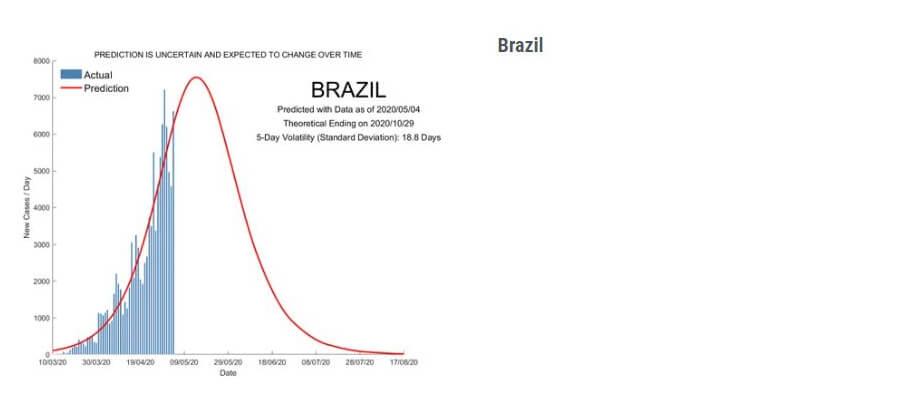By Thays Teixeira
Physicists from several countries and especially those linked to the Brazilian Physics Society (SBF) contest the data presented by the Data Innovation Laboratory at the University of Singapore, Asia, which states that the pandemic will come to an end in Brazil in early July. The researchers state that this type of predictive model is mistaken because it does not consider the complexities of Covid-19 or the particularities of the disease’s behavior in our country.
The physicist and professor of the Physics Department at the Federal University of Rio Grande do Norte, José Dias do Nascimento, who has a mathematical model that analyzes the behavior of the pandemic in Brazil explains that this type of prediction has serious problems from the mathematical and physical point of view , and that should therefore be discarded when analyzing a scenario as complex and varied as the Brazilian one.
“These models are a disservice because they have hypothesis problems, and second, they have data problems. The SIR models (sensitive, S; infected, I; and removed, R) as they do, have no E compartment, which in the model we propose concerns the Exposed. Covid-19 has a particularity that are asymptomatic and they change the time of the epidemic history ”, explains the professor at UFRN.
In the estimate made in Singapore with previous data on susceptible, infected and recovered (removed) people from Covid-19 – a model known in scientific language as SIR, as mentioned by the professor – the Brazilian situation would have lower rates and peaks. However, the fact that they do not consider those exposed, to mitigation actions (isolation for example), number of beds, the logic of the health system make these data mistakenly contemplate the reality of Brazil, leading to serious health problems. interpretation and measures taken by managers.
Thus, the model presented by Singapore results in a gigantic simplification on the Brazilian reality and causes a disservice to the measures taken to combat the disease. “This implies a gigantic problem, because if used wrongly by politicians who want to defend the economic return, who use these models that give a bad or unrealistic result to justify a return earlier as is happening in some cities in São Paulo , they end up creating an even bigger problem ”, points out José Dias.
The researcher explains that combating these erroneous or poorly prepared data is a function of science and scientific committees in general.
In the case of this model, some researchers from Brazil, Iran, India, Germany, China and other countries made an argument against showing that the transmission curve was not correct. The researchers created a virtual meeting in order to show mayors that these surveys were not serious and did not have the predictive power they demonstrated. Professor José Dias is part of this team that questions the data validity of this simplified predictive model.
Data cannot be validated
In a note, the researchers explain why the Singaporean predictive model is an error when dealing with the model and the perceived reality in Brazil. In the text, leading researchers in the country and in the world indicate these mistakes and the danger of them.
“The forecasts of the Singapore laboratory follow a model of spreading the epidemic called SIR (Susceptible-Infected-Removed). This model adopts some simplifications, for example, the model does not consider demographic data, effects of isolation measures and characteristics of the health system. Even assuming that the SIR model is adequate, the adjustment method ignores problems with the data ”, says the note presented by the research groups Ação Interdisciplinar COVID-19 and COVID-19 BRASIL.
“The forecasts are offered without any uncertainty estimates, inducing a false impression of accuracy. The spread of the epidemic follows an exponential curve in its initial stage. In countries, such as Brazil, where the number of cases is still growing rapidly, only data from this initial stage are available for estimation. Any measurement error present in the data is amplified several times by the characteristic of the exponential curve. Therefore, forecasts using the SIR model at this stage have low reliability, ”says the note signed by the researchers.
For these reasons José Dias and other researchers question the veracity of the data, in addition to recalling that the article presented is a very light page of theoretical argument that has not been published in journals or places of scientific strength that could validate these numbers or undergo evaluation. pairs.
“A model for regions like Brazil and specifically Rio Grande do Norte needs a very careful statistical analysis, because the country has several ‘brasis’ and each location has particularities that imply different weights and that make a difference in the validation and veracity of the observed data ”, explains the physicist, adding that it is necessary to be very careful with the hypotheses when we observe a model or simulation, especially those that consider epidemic conditions.
The results presented by the UFRN researcher model do not corroborate the results pointed out by the Singapore Laboratory and detail in more depth the reality of the Brazilian data on the Coronavirus pandemic.
Concern for society is constant
To better understand this dynamics and the basic premises of the models developed by these groups, in addition to knowing actions already implemented in other countries, the International Physics Institute (IIP) (www.iip.ufrn.br) of the University Federal of Rio Grande do Norte held on April 14th and 15th a virtual seminar that discussed the dissemination of Covid-19 and pointed out possible public policies that may be of great importance for Brazil.
According to the organization and its members, the ambiguity of speeches about the severity of the epidemic or, even worse, its denial, compromise the necessary isolation measures and their effectiveness. Which reveals the serious problem that is grounding public actions considering wrong and even wrong data, which have no scientific validity.





